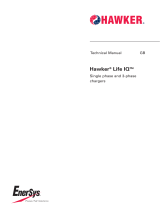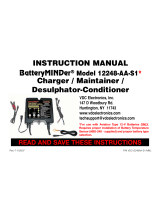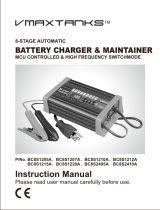Page is loading ...

Fiamm Motive Power
Premium ES
Instructions for use GB

Safety instructions
AIM OF THIS MANUAL
This manual is designed for use by any skilled worker
wishing to use Fiamm Motive Power Premium ES battery
chargers for recharging lead/acid vented, (with or without
electrolyte mixing),valve regulated AGM and gel batteries.
This manual provides details of:
•The chargers’ functions.
•Any adjustments required and how to use the chargers.
When producing this manual, Fiamm Motive Power has
aimed to provide its information in as simple and precise
a manner as possible but cannot assume any responsibility
for any misinterpretation.
The owner of the equipment is required to retain this
manual throughout the equipment’s life and to pass it on
to any purchaser in the event of its resale.
GUARANTEE
The manufacturer covers the guarantee in accordance with
the local regulations. Please contact your dealer for more
detailed information.
RECOMMENDATIONS
This manual contains information and advice that should be
followed by the operator to ensure his safety and maintain
the equipment’s safe condition.
Recommended use
This manual should be read through carefully before using
the equipment and also read by anyone likely to use the
equipment. The equipment:
•Presents no obstacles to the free circulation of air
through the air inlet and outlet but, nevertheless,
should be cleaned of dust every six months by a
qualified person.
•Must be used in conformance with its indicated level
of protection and never come into contact with water.
•Must be used within the temperature limits stated in
the technical characteristics.
•Must not be installed on surfaces subject to vibration
(near to compressors, engines, motors, etc.).
Operator safety
Take all necessary precautions when the equipment will be
used in areas where there is the possible risk of an accident
occurring. Ensure appropriate ventilation according to
standard EN50272-3 to allow any gases released to escape.
Never disconnect the battery while it is being charged.
ELECTRICAL SAFETY
The prevailing safety regulations must be observed.
The system protection installed on the power supply
to the charger must conform to the charger’s electrical
characteristics. The installation of a suitable circuit breaker
is recommended. It is imperative to ensure that when fuses
are being replaced only fuses of the specified type and of
the correct calibre are used. It is strictly forbidden to use
inappropriate fuses or to short-circuit the fuse holders.
This equipment conforms to Class 1 safety standards, which
means that the appliance must be earthed and requires to
be powered from an earthed supply. Earthing is provided
by means of a braid or cable of cross-section in excess of
or equal to 6 mm2; this cable must be as short as possible.
Before opening the equipment for the purposes of
adjustment, replacement of components, maintenance
or repairs, it must be disconnected from all sources of
electrical power (including mains and battery power).
The battery must only be disconnected after the Stop/Start
button has been pressed (see on models 1 and 2 on
following page) or the Start/Stop button has been set to “0”
(models 3 and 4). Any adjustment, maintenance or repairs
to the equipment while it is open must only be carried out
by an appropriately skilled person who is aware of the risks
involved.
Contact one of the company’s trained technicians if any
problem is encountered when putting the charger into
operation.
LIMITATIONS ON USE
This equipment has been designed for indoor use. It is
only designed to recharge lead/acid batteries on industrial
premises.
DESTRUCTION OF THE EQUIPMENT
When the equipment becomes obsolete, the casings
and the other internal components can be disposed of by
specialist companies. Local legislation takes precedence
over any instructions in this document and must be
scrupulously observed (WEEE 2002/96 EEC).
IMPROVEMENTS AND MODIFICATIONS
Fiamm Motive Power reserves the right to make any impro-
vements and/or modifications to the product described in
this manual at any time and without prior notice and is not
obliged under any circumstances whatsoever to update
the contents of this manual nor the equipment concerned.
RECEIPT – STORAGE
Upon receipt of the package, check for any external or
internal damage and, if necessary, notify the haulier at his
usual premises, by recorded delivery letter, fax or telex,
within 24 hours of delivery.
If the charger is to be stored before its use, it must be kept
carefully sealed in its original packaging. It must be stored
in a clean and dry location at a moderate temperature
(-20°C to +40°C). Equipment stored at a temperature of
less than 15°C must be brought progressively to operating
temperature (over a period of 24 hours) to avoid any risk of
condensation causing electrical faults (particularly
short-circuits).
REPLACEMENT PARTS
The equipment’s production number must be supplied
when ordering any replacement parts. This number can
be found on the information plate.
INFORMATION PLATE
This is located on one side of the charger.
EEC DECLARATION OF CONFORMITY
Fiamm Motive Power hereby declares that the char-
gers in the Premium ES range covered by this
declaration conform to the descriptions laid down
in European Directives
· 89/336/EEC:
EN61000-6-2, EN61000-6-4: Immunity and
emissions limits for industrial electronics
(Class A - Industrial Environments)
· 2006/35/EC:
EN60950, EN60335 (Low Voltage Directive)
· RoHS 2002/95/EEC.
ENGLISH

Model 1 Model 2
Model 4Model 3
Model 4Model 3
Model 2Model 1
4
5
2
4
5
2
STOP / START
•Before opening the charger (only by qualified
electrical personnel) disconnect battery and mains.
•Déconnecter le chargeur du réseau et de la
batterie avant toute intervention sur le chargeur
(uniquement par une personne autorisée).
•Vor Abheben der Haube (nur von Elektrofach-
kräften) erst Netz und Batterie abtrennen.
•Ontkoppel altijd eerst batterijstekkers en
netstekker voor men de lader-afdekking
verwijdert (uitsluitend door bevoegd personneel).
3
2
3
2
4
1
1
Presentation & Use
INTRODUCTION
The Premium ES range of chargers enable batteries to be
recharged from the mains supply. They can recharge 24V,
36V, 48V, 72V or 80 V batteries (depending on the version
supplied).
The microprocessor control automatically recognises the
battery’s voltage, capacity, state of charge, etc., providing
optimum battery control from highly efficient analyses of its
condition. Several charging profiles are available for free
electrolyte vented lead/acid, batteries: ionic and pneumatic
mixing, valve-regulated AGM and gel, battery types,
depending on the user’s configuration. Moreover,
desulphation, equalizing and refreshing charges are also
integrated.
UNPACKING
The charger is supplied with the following components:
•A power cable 3 metres long.
•A battery cable 3 metres long.
•The present Installation Instructions.
•The Technical Characteristics sheet.
GENERAL CHECKS
Before putting the charger into service, we recommend that
you check:
•That it is correctly earthed.
•That the local power supply conforms to the charger’s
operating voltage.
•That the battery voltage conforms to that of the charger.
•That the charger’s output is suitable for the battery’s
capacity.
EXTERNAL COMPONENTS
The general components are shown below:
Ref. Function
1. Power supply cable.
2. Screws holding the cover.
3. Wall fixing.
4. Ventilation holes.
5. Display and controls (refer to next figure).
6. Battery cable.
7. Wall mounting bracket
CONTROL PANEL
This contains the display and the control buttons. Please
refer to the sections The meaning of the lights and LCD
fault messages for details of the information shown.
No. Function
1. Start-Stop or Stop/Start switch.
2. Green ‘Charging completed’ light (battery charged).
Unlit: charger stopped or battery not available.
Flashing: thermal fault.
Permanently lit: battery available.
3. Red ‘Fault’ light.
Unlit: charger stopped or battery not in charge.
Flashing: charger fault.
Permanently lit: ‘Charging in progress’.
4. LCD display.
5. Button for exiting the menu, initiating equalisation
and initiating desulphation.
MECHANICAL INSTALLATION
The charger must be mounted on the wall free of vibrations
in a vertical position (except for floor standing chargers).
For wall-mounted chargers, the lower part of the charger
must be at least 0.60 m from the floor and/or the charger
below and the upper part 1.0 m from the ceiling. The
minimum distance between two chargers must be 0.50 m.
You must avoid areas where the chargers may be splashed
with water.

The charger must be held by 4 fixings suitable for the type
of support. The drilling pattern varies according to the
model of charger (please refer to the technical brochure).
ELECTRICAL CONNECTION
To the mains supply
You may only connect to the 1-phase 230Vac or 3-phase
400Vac mains supply (depending on the type of the charger)
via a standard socket and an appropriate circuit breaker
(not supplied). The current consumption is shown on the
charger’s information plate.
To the battery
Polarity must be observed. Any reversal of polarity will blow
the output fuse, prevent charging and cause DF fault code
to be displayed (on model 4). Please refer to the Fault
Messages section.
The charger must be connected to the battery by the cables
supplied:
•The RED cable: to the battery’s POSITIVE terminal.
•The BLACK cable: to the battery’s NEGATIVE terminal.
CHARGING THE BATTERY
(CHARGERS WITH LIGHTS ONLY)
Initiating charging
1. Models 1 and 2: Connect the battery.
Model 3: Switch the Start/Stop switch to position “1”.
The “Charging” and “OK” lights flash, depending on the
charging profile, as follows:
Flashing alternately Ionic (1 red/1 green)
Flashing simultaneously Other (depending on order)
Gel (red and green)
Pneumatic (3 red/1 green)
After approximately 30 seconds, the red “CHARGING”
light illuminates permanently. If this does not happen,
refer to the paragraph on “The meaning of the lights”.
2. Charging is initiated and starts automatically.
Completion of charging
1. The green “OK” light stays on permanently.
The battery is charged and ready for use.
2. Switch the Start/Stop switch to “0” (Model 3).
3. Disconnect the ready to use battery.
On model 1 and 2 you can stop the charge by pressing the
Stop/Start button.
If the battery remains connected, in order to keep it charged,
compensation and subsequent equalisation charging opera-
tions will be initiated automatically.
Completion of charging with equalisation (Models 2 and 3)
Equalisation only concerns vented lead/acid batteries.
It will be initiated manually or automatically by switch
Manual initiation
1. As soon as charging is complete (the green light is
permanently lit or is flashing), press the button.
The red light permanently lit indicates that equalisation has
been initiated
2. The battery is ready for use as soon as the green light
illuminates.
Automatic initiation
If equalisation has been programmed, equalisation charging
is initiated automatically.
Desulphation
• Either starts automatically when the battery is heavily
discharged; the length of the desulphating operation
is defined by the charger’s electronics. The charging
process is initiated automatically at the end of the
desulphation period.
• Or is initiated manually, as shown below.
To initiate desulphation manually:
Can be carried out on models 2 and 3 equipped with
desulphation button.
1. Press STOP button to stop the charge. The 2 lights are
unlit.
2. Press the while maintaining the STOP button
pressed.
The red light illuminates. Desulphation charge is initiated.
3. End of charge : the green light is lit. The battery is ready
for use.
CHARGING THE BATTERY
(CHARGERS WITH LCD DISPLAY ONLY)
The charger can only be started when a technically
compliant battery is connected to it (type, capacity, voltage).
Initiating desulphation before charging
Desulphation of a vented lead/acid battery:
•Either starts automatically when the battery is heavily
discharged; the length of the desulphating operation
is defined by the charger’s electronics. The charging
process is initiated automatically at the end of the
desulphation period.
•Or is initiated manually, as shown below.
To initiate desulphation manually:
1. Set the Start/Stop switch to “0”.
2. Hold down the button.
3. Set the Start/Stop switch to “1”.
Release .
Desulphation is initiated for the programmed period.
The charging initiation process must be started manually
on completion of the desulphation period.
Initiating charging
1. Set the Start/Stop switch to “I“.
The display shows the information on the battery
connected and counts down the time remaining before
effective charging starts.
Once the two-minute countdown is complete, the display
shows the information on the charging operation.
Faults can prevent charging. Please refer to the section
on Fault Messages.
During charging
The display shows the information on the charging
operation.
Information displayed
Sign Type of measurement Example
UBattery voltage (V). 26.1
uVoltage per cell (V). 2.18
IInstantaneous charging current (A). 55
CCapacity recharged (Ah). 71
tCharging time spent (hh:mm). 03:36
HEstimated remaining charging
time (hours). 05
DF No. of any fault occurring.
See § Fault Messages. DF5
Completion of charging without equalisation
1. The green light illuminates when charging has been
completed correctly.
The green ‘charging complete’ light is illuminated and
the message AVAIL is displayed. The display shows, in
alternation:
•The charging time taken.
•The number of amp hours recharged.
Any other visual indication from any of the three lights
indicates a problem during charging.
If the battery remains connected, in order to keep it
charged, compensation and subsequent equalisation

charging operations will be initiated automatically,
depending on the type of battery.
If the green light is flashing, the battery is in its resting
phase.
Wait until the light stops flashing.
2. Set the Start/Stop switch to “0”.
3. Disconnect the battery, which is now ready for use.
Completion of charging with equalisation
Equalisation only concerns vented lead/acid batteries.
It can be initiated either manually or automatically.
Manual initiation
1. As soon as charging is complete (the green light is
permanently lit or is flashing), press the button.
The messages EQUAL I = (equalisation current) and
EQUAL H = (remaining equalisation time) indicate
that equalisation has been initiated.
2. The battery is ready for use as soon as the green light
illuminates.
Automatic initiation
If equalisation has been programmed, equalisation charging
is initiated automatically.
Furthermore, if the battery remains connected, in order
to keep it charged, maintenance charges (compensation
and subsequent equalisation charging operations) will be
initiated automatically, depending on the type of battery.
The same information as for manual initiation is displayed
(see above).
THE MEANING OF THE LIGHTS
Lights Cause Remedial action
Red & Start of the charge. None. See §
green flashing. “Charging”.
Red permanently Normal status Wait until charging
lit & green unlit during charging. is complete,
indicated by the
red light going
out and the green
light illuminating.
Red flashing No current to Check and/or
& green unlit. the battery. change the output
fuse.
Red unlit & Charging complete. Battery ready.
green perm. lit.
Red unlit & Thermal fault
Check battery voltage.
green flashing. (ambient tempe- Charge is stopped.
rature too high, Check the char-
no ventilation), ger’s installation
or battery voltage and operating
too high or too low conditions.
Red perm. lit Air pressure fault. Check the air
& green flashing. Charging in circuit.
progress.
Red & green Profile Check the switches
permanently lit. configuration error. configuration.
Red and green No mains supply Check the power
unlit. supply voltage.
Defective power Check the power
supply fuse. supply voltage
against the
voltage accepted
by the charger
and the fuse.
Battery not Check that the
connected. battery and/or
the battery cable
is correctly
connected
LCD Fault messages
Fault Cause Remedial action
No No mains supply. Check the power supply
display and the input fuse(s).
DC Appears before a DF1
fault is displayed.
DF1/DF2* Charger fault. Check the power supply
voltage.
Check that the battery
is correctly connected
(that the cables are not
reversed) and check the
output fuse.
DF3* Unsuitable battery. Battery voltage too high
or too low. Connect the
correct battery to the
charger
DF4 The battery has been Charging continues.
discharged more than
80% of its capacity.
DF5 Battery requires Check the charging
inspection. cables (cross-section
too small), the terminals
(oxidisation, not tight)
and the battery
(defective cells).
DF7 Pneumatic mixing air Check the air circuit
circuit fault (pump, tubing).
(the red light flashes).
TH* Thermal fault resulting Check that the fan(s) is
in interruption of (are) working correctly
charging. and/or that the ambient
temperature is not too
high or whether there is
poor natural ventilation
to the charger.
(*): A blocking fault preventing charging from continuing.
TECHNICAL CHARACTERISTICS
Refer to the Technical Characteristics sheet joined to the
charger.
Subject to technical modification without any prior notice.

European Headquarters:
EnerSys EMEA
EH Europe GmbH
Löwenstrasse 32
8001 Zürich
Switzerland
Phone: +41 44 215 74 10
Fax: +41 44 215 74 11
www.enersys-emea.com
04.2007 Subject to modification without prior notice.
/




